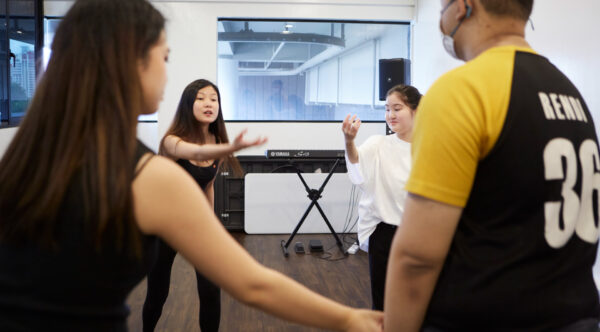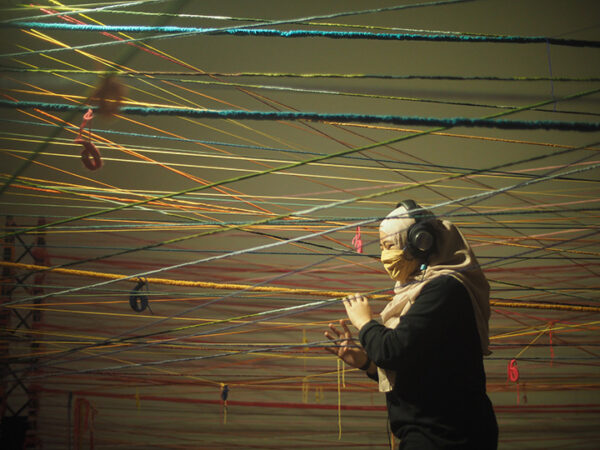
Unseen Art Initiatives presents Move For?ward at the National Gallery of Singapore
“It is important for industry professionals to commit and support access work on a long-term basis because it builds trust and serves as advocacy for disability-led works.”
Aspiring artists with visual impairment in Singapore often encounter a lack of options in the arts curriculum in their creative pursuits and expressions. By defaulting most sighted students to the visual forms of artmaking such as painting, the curriculum design often embeds biases in grading criteria and the activities would usually exclude visually impaired students. Unseen Art Initiatives has recognised the gap in the arts education ecosystem and has initiated programs that successfully gather, mentor and showcase visually impaired artists and their works to the public.
Unseen Art Initiatives presented Move For?ward at the National Gallery of Singapore (NGS), an art installation by artists Claire Teo, Kira Lim, Samuel Woo and Clarence Chung and 12 visually-impaired co-creators, best exemplified the diversity and equity in creative collaboration, programming and commissioning work of disabled artists in the following ways:
- Developing industry skills
The Unseen: Constellations (2014-2016) pilot program paired young visually impaired students and volunteer mentors in professional workshops via interest-matching and different vocational interests such as criminal psychology, theatre and performance, music composition and sound design, public speaking, film-making, script writing and visual exhibition making. - Conducting pilot experiments
Participants of the Unseen: Inside Out (2020-2022) program met regularly in small workshops to explore voice and movement as alternative mediums to express the voices of the visually impaired community and share feedback. - Focusing on co-creation
Artist-Facilitators with a wide range of expertise (co-creators, sound composer and designers, access consultants) collaborated on the curatorial direction of the Move For?ward exhibition alongside 12 visually impaired co-creators who shared their life stories. - Building strategic partnerships
Working with the in-house Access Team at the National Gallery of Singapore unlocked new ways to push forward the Unseen: Inside Out program. Aligning with a festival schedule increased foot traffic and attracted new audiences to the Move For?ward exhibition despite the COVID-19 restrictions on crowds.
Founded by artist Alecia Neo in 2014, Unseen Art Initiatives is a platform which organises socially engaged, interdisciplinary and experiential projects that focus on the production and curation of inclusive art projects. It was at the Unseen: Constellation (2014-2016) installation that participant-turned artist Claire Teo first gained exposure to the possibility of pursuing a career in the arts and began her interest in the performing arts with the support of volunteer mentors Sharda and Sean Harrison from the Pink Gajah theatre. For example, Claire received audition guidance for school applications from Sharda and with this added support combined with her perseverance and talent, Claire became the first visually impaired person to graduate with the Diploma of Performance from LASALLE College of the Arts in Singapore. Claire contributes to Unseen’s platform as lead artist of Unseen: Inside Out, working alongside other artists and co-creators.
Developing industry skills
Following the positive outcomes from Unseen: Constellation (2014-2016), the student mentorship pilot program which paired young visually impaired students and volunteer mentors via interest-matching and different vocational interests (e.g., criminal psychology, theatre and performance, music composition and sound design, public speaking, film-making, script writing and visual exhibition making), Unseen: Inside Out (2020-2022) was the workshop process that led to the Move For?ward program. It brought forward learnings from the mentorship program and continued to provide ongoing skills development opportunities for visually impaired students who met and interacted with the artists in professional workshops.
The artists would customise their working approaches according to each participant’s profile and their areas of vocational interest; for example, movement performance techniques, storytelling and composing sound works. Incorporating both sensory and tactile methods of teaching, Artists Claire Teo and Kira Lim, Sound Composer and Audience Experience Lead Clarence Chung and Installation Designer Samuel Woo, have all provided industry insights to better support the 12 visually impaired co-creators in the making of the Move For?ward exhibition. It is important for industry professionals to commit and support access work on a long-term basis because it builds trust and serves as advocacy for disability-led works.

Lead Artist Claire Teo (left) and co-creator Sherri Lim (right) engaging in a movement exercise during a workshop session. Photo credit: Unseen Art Initiatives.
Conducting pilot experiments
Through the Unseen: Inside Out program, a diverse group of 12 participants met two to three times a month in small workshops facilitated by Lead Artist Claire Teo and Key Artist Collaborator Kira Lim, to collectively explore how to express the voices of the visually impaired community via alternative mediums such as scripting, performance and voice, beyond the usual image-based frameworks. These workshops provided opportunities for participants to bounce feedback between themselves about which approaches were working and which were not. In these workshops, personal lived experiences were also exchanged between participants. The post-workshop feedback sessions were helpful in addressing these concerns:
- being critical about the core mission in representing a spectrum of voices of visually impaired creatives rather than simply branding the work as disability-led exhibition
- reviewing gaps between executing concepts according to traditional theory and the actual application when making accessible works
- adjusting any concerns and making space for other advice and expertise.
Focusing on co-creation
While it is common to label a project by crediting the main organiser (i.e., community-led or artist-led), the Move For?ward exhibition emphasised the importance of co-creation and leveraged connections in the arts ecosystem to involve both sighted and non-sighted members. The project was grounded in the personal narratives of the 12 co-creators, who worked with the artists, sound composer, designers and producers to create a sensorial, immersive and accessible maze art installation of sound works with real voices. Thesoundtracks prompt audiences to either move forward or pause based on their reaction to the audio, which offered a glimpse into the lives of the co-creators and aimed to shift pre-conceived notions of the disabled community and encourage meaningful social change.

The creative team stand in cheerful, dynamic poses amid a maze of ropes which was a prototype of the Move For?ward artwork. (From left to right) Alecia Neo, Charles Teo, Athriah Annissa, Claire Teo, Neo Kah Wee, Samuel Woo, Jesslyn Lim and Clarence Chung. Photo credit: Unseen Art Initiatives.
Building strategic partnerships
Instead of securing a separate venue to launch the Move For?ward exhibition as a standalone event, Unseen Art Initiatives pitched the project to the National Gallery of Singapore (NGS) to be included in the line-up of the annual Light to Night Festival, which ran from 14 January to 3 February 2022. The venue partnership also allowed Unseen Art Initiatives to collaborate with the gallery’s in-house Access Team, which sat in consultations during the development phase of the Move For?ward exhibition. Constructive feedback was provided to the producers about access for autistic, deaf and wheelchair users. The multistage consultation process combined the expertise of both sighted and non-sighted individuals. As a result of this strategic partnership, the Move For?ward exhibition was able to leverage the marketing and mass reach of the gallery, which led to heavier foot traffic and was well attended as a public event. To further enrich the experience for attendees viewing the exhibition at the festival, co-creator tours were available to provide more in-depth insight and understanding for new audiences.

A member of the public navigates the maze of colourful ropes with touch while listening carefully to an audio track in the completed Move For?ward installation at the National Gallery of Singapore. Photo Credit: Samuel Woo.
The Unseen: Inside Out program’s Move For?ward exhibition at the National Gallery of Singapore is an example that access work requires long-term commitment in advocacy, knowledge sharing, community engagement and the mobilisation of networks and resources. The program and exhibition had generative impacts for the collaborators involved and set benchmarks for other organisations and practitioners interested in access work to follow. While the artistic interventions may vary, it is crucial for access work to highlight the transformative value in doing the work and not merely casting a spotlight on disability. The resource pool and audience segment for access work remains limited in Singapore; however, Unseen Art Initiatives is well-positioned to nurture disabled artists to showcase their works on international stages and hold arts leadership roles now and in the near future.
Wennie Yang
| Wennie Yang is a finance administrator and cultural worker originating from Toronto, Canada with arts management experiences in organisations spanning from Toronto and to Singapore (Luminato Festival, Writers Guild of Canada, Toronto International Film Festival, Chan + Hori Contemporary, Singapore International Film Festival). After graduating with a Bachelor of Accounting & Financial Management at University of Waterloo, she further completed her MA in Arts and Cultural Leadership at LASALLE College of the Arts. Now based in Singapore, Wennie actively pursued opportunities in optimising not-for-profit processes through pro-bono skills volunteering, as well as documenting regional events in Southeast Asia as a Freelance Contributor to ArtsEquator |
What is the Imagine Around the World Project?
A partnership with the British Council Australia, the Imagine Around The World Project aims to document case studies from numerous countries outside of US, UK, Canada, Australia and New Zealand to share best practice and leadership in cultural diversity, cultural equity and inclusion in the arts, screen and creative sectors. This project is managed by Diversity Arts Australia and supported by Creative Equity Toolkit partner, British Council Australia. To find out more click below – or read the other case studies as they go live here.

